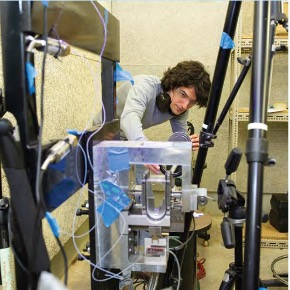Since its creation in 2016, the PLuS Alliance has made seed funding available to support the development of new and early stage collaborations across Arizona State University, King’s College London and UNSW Sydney. One collaboration has resulted in the creation of a smartphone blood-iron analyser, which aligns with the United Nations Sustainable Development Goal No. 3 and has the potential for global impact.
Common blood disorders
Iron deficiency, a leading cause of anaemia, is one of the world’s major nutritional disorders, according to the World Health Organisation (WHO). A target has been set for a 50% reduction of anaemia in women of reproductive age by 2025. It is estimated by WHO that one in four people globally suffer from anaemia.
Hemochromatosis is another blood disorder associated with excess iron that is usually diagnosed late in the stages of irreversible organ damage. Hemochromatosis is a genetic disease with an incidence of one in 200 people of northern European origin. This disease is characterised initially by vague symptoms such as fatigue and can progressively worsen, leading to damage in various organs and liver disease, pancreatic impairment (diabetes), heart arrhythmias and failure, and neurodegenerative disorders.
How is the PLuS Alliance helping to combat iron-related diseases?
Dr Erica Forzani is a PLuS Alliance Fellow and Associate Professor at Arizona State University (ASU) in the School for Engineering (Matter, Transport & Energy). Her research concentrates on the development of novel hybrid sensors and their integration into wireless, passive and inexpensive medical devices, such as mobile phones.
Dr Forzani and the late Professor N.J. Tao at ASU, along with post-doctoral researcher Michael Serhan, Professor Wolfgang Maret and Dr Ismael Diez Perez at King’s College London, have been working on low-cost point-of-care (POC) technology that measures blood iron markers, with the goal of both preventing and treating iron-related disorders. This would represent a significant advancement in healthcare delivery systems, cutting out blood-testing procedures and processes that one normally requires when being tested in a hospital or clinic.
Dr Forzani says: "Since abnormally low or high blood-iron levels are common worldwide and can be of serious detriment to human health, a ubiquitously available technique for measurement of blood iron could represent a substantial improvement in point-of-care medical technology for monitoring iron-related blood disorders and could potentially spark a trend toward proper early prevention of diseases and health maintenance throughout the life span. Here, we aim to introduce a smartphone-based colorimetric detection system for iron measurement."
How has the method of detection been improved?
Dr Forzani and her colleagues at ASU and King’s College London have achieved significant milestones in recent months in terms of the method of assessment. Using a smartphone app and a sensor strip, critical indicators of low and high blood-iron levels can be obtained.
The smartphone mount is robust and controls the light source of the colour-reading app, which is calibrated to obtain iron-concentration results. Major improvements have been made to the design of the dry-sensor strip to include three additional membranes that are sandwiched vertically and compressed to ensure proper wicking – i.e., drawing and absorption of the fluid sample through the membranes as well as separating cellular components of the blood via porosity. “We changed from a generation 1 sensor to a generation 2 sensor that now includes three additional membranes for whole blood separation and processing,” says Michael Serhan.
How much does this new process cost compared with the traditional process?
One of the most important aspects of inventing, developing and producing an application is the cost. For the benefits to be realised globally the cost of the application could be lower dramatically compared to existing costs, because the number of interventions have been drastically reduced.
Assuming the smartphone is already owned by the tester, the test cost includes two components: a one-time investment to acquire the smartphone mount, and the cost of the sensor strip. The smartphone mount costs about US$13. The sensor strip cost is around US$0.06. Although the current version of the test takes the centrifugation step for serum separation from blood into account, in the future the sensor strip will accommodate whole blood from human capillary puncture, which will not add substantial cost to the sensor strip. Therefore, the cost can be driven down from the current rate of $25 to under $0.06 per test.
“ The state-of-the-art method for measurement of iron metabolites includes a blood draw, processing of the blood sample as well as performing complex instrumental testing. These steps require experienced personnel as well as expensive equipment, contributing to the costly examination,” says Michael Serhan. “We believe that our device can complement a physician in two ways:
- The physician can access your data and make a quick judgement about whether further consultations are needed.
- With more data, the physician can give more confident assessments to ensure unnecessary burden on the patient.
What happens next?
The next step is to conduct a pilot study on a group diagnosed with iron-deficiency anaemia as well as a cohort diagnosed with hemochromatosis. The tests will try to identify correlations between each sub-group and iron levels in real time.
Michael Serhan: “One of the positive outcomes from the pandemic is that it has shone a light on the importance of diagnostic devices and medical devices. In the coming weeks and months, we may be able to test the sensors and measure iron levels and total iron mining capacity in the COVID-19 population versus healthy individuals. From what we know so far there is likely to be a decrease in iron levels in individuals with the virus as opposed to people without it, so this is another biometric test to assess people impacted by the virus and understand more about how the virus affects the body, what is happening to physiology and how the body behaves with the virus. The more we can find out about the virus and understand how to tackle the challenges presented the better.”
What is the potential impact of this app?
The current process for getting a blood test result will be revolutionised by the introduction of the smartphone blood-iron analyser. In those parts of the world where people have a smartphone, a range of reasons could impact one’s ability to get a test – for example, poor infrastructure, work and care responsibilities, hospital policies regarding the number of times blood can be tested, time-consuming and invasive blood tests and COVID-19 restrictions. The smartphone app could be a gamechanger. It would be possible for patients to take a test more often than if they had to go to a hospital or clinic. With the generation 2 smartphone sensor, iron levels can be tracked in real time, empowering the management of iron disorders. Iron levels can be tracked so that the disease can be managed better, before it gets to a critical point. The new method can provide accurate results in intra-laboratory and inter-laboratory verification and improves mobility and lowers costs – two key drivers of improving global healthcare.
Dr Erica Forzani was named recently as a senior member of the National Academy of Inventors
In February 2021, Dr Forzani was named as a senior member of the National Academy of Inventors (NAI) for her contribution to the development of many important medical devices and technological advances during her career, particularly in the area of monitoring patients' metabolisms. Dr Forzani holds 10 patents, has been part of 11 patent applications and three transfers of intellectual properties, and has written more than 90 peer-reviewed publications in science, engineering and medical research journals.
Among the achievements that have earned her NAI senior member status are the first mobile device capable of detecting inflammatory biomarkers for asthma, the first point-of-care mobile sensor for real-time detection of carbon dioxide, the first mobile metabolic rate tracker, and a device that detects ammonia in biological fluids to diagnose signs of urea metabolism problems, liver disease and other diseases. The smartphone blood-iron analyser initiated with the support of the PLuS Alliance will be another weapon to help tackle global healthcare issues.
To read more about the PLuS Alliance and its research collaborations, sign up to our newsletter here.
For media inquiries, contact Bisi Olulode, Communications Officer, olabisi.olulode@plusalliance.org
Follow us on Twitter at @PLuSAlliance


